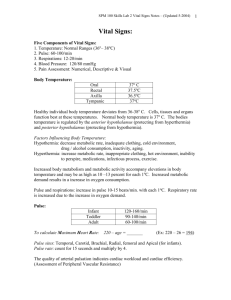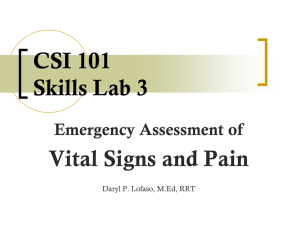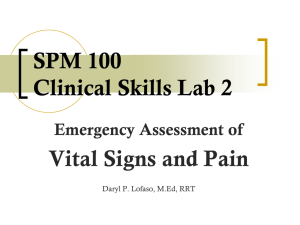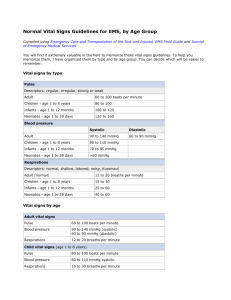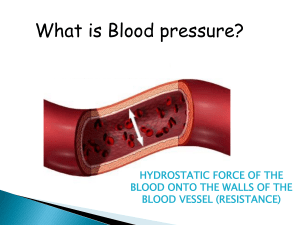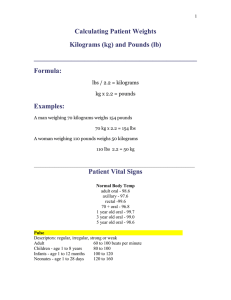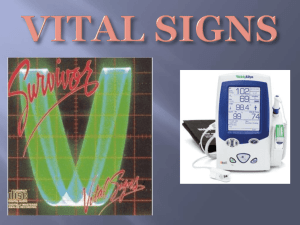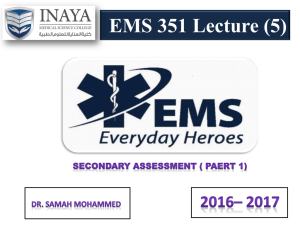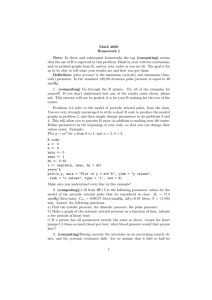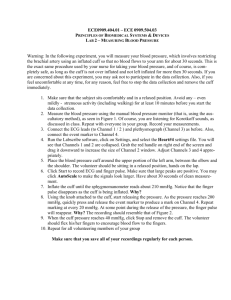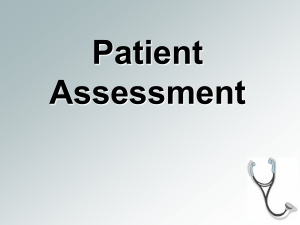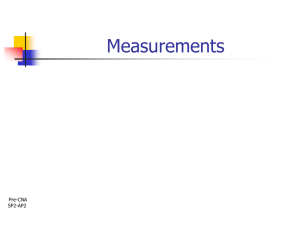Vital Signs: Skills Lab Notes for Nursing Students
advertisement
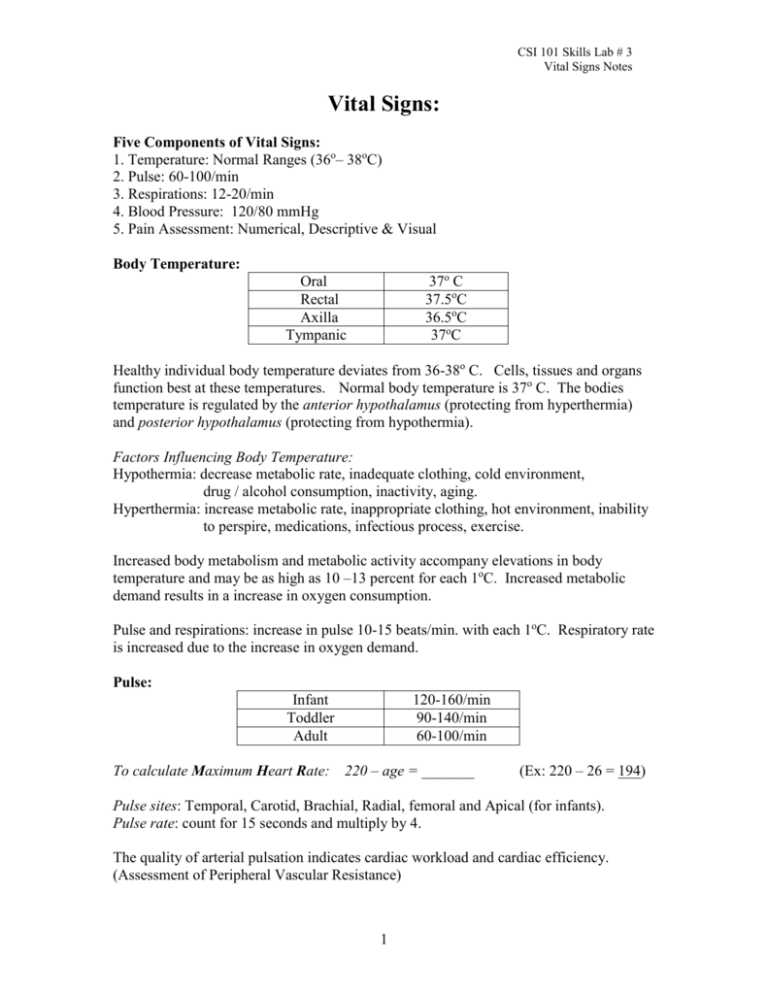
CSI 101 Skills Lab # 3 Vital Signs Notes Vital Signs: Five Components of Vital Signs: 1. Temperature: Normal Ranges (36o– 38oC) 2. Pulse: 60-100/min 3. Respirations: 12-20/min 4. Blood Pressure: 120/80 mmHg 5. Pain Assessment: Numerical, Descriptive & Visual Body Temperature: 37o C 37.5oC 36.5oC 37oC Oral Rectal Axilla Tympanic Healthy individual body temperature deviates from 36-38o C. Cells, tissues and organs function best at these temperatures. Normal body temperature is 37o C. The bodies temperature is regulated by the anterior hypothalamus (protecting from hyperthermia) and posterior hypothalamus (protecting from hypothermia). Factors Influencing Body Temperature: Hypothermia: decrease metabolic rate, inadequate clothing, cold environment, drug / alcohol consumption, inactivity, aging. Hyperthermia: increase metabolic rate, inappropriate clothing, hot environment, inability to perspire, medications, infectious process, exercise. Increased body metabolism and metabolic activity accompany elevations in body temperature and may be as high as 10 –13 percent for each 1oC. Increased metabolic demand results in a increase in oxygen consumption. Pulse and respirations: increase in pulse 10-15 beats/min. with each 1oC. Respiratory rate is increased due to the increase in oxygen demand. Pulse: Infant Toddler Adult 120-160/min 90-140/min 60-100/min To calculate Maximum Heart Rate: 220 – age = _______ (Ex: 220 – 26 = 194) Pulse sites: Temporal, Carotid, Brachial, Radial, femoral and Apical (for infants). Pulse rate: count for 15 seconds and multiply by 4. The quality of arterial pulsation indicates cardiac workload and cardiac efficiency. (Assessment of Peripheral Vascular Resistance) 1 CSI 101 Skills Lab # 3 Vital Signs Notes Factors Influencing Pulse Rate: Exercise Temperature Emotions Drugs Hemorrhage Increase short-term fever & heat pain, anxiety + chronotropic (epi) loss of blood Decrease trained athletes hypothermia severe pain - chronotropic (digitalis) Quality of the pulse is assessed and may be noted on a point scale: 3+ - bounding – increase stroke volume 2+ - normal 1+ - weak thready – decrease stroke volume O – absences Respirations: New Born Child Adult 35-40/min 20-30/min 12-20/min Factors Influencing Respiratory Rate: Exercise Acute pain Anxiety Smoking Narcotic Increase rate & depth rate & depth rate & depth rate Decrease rate & depth Tachypnea – increased respiratory rate. > 24/min. Bradypnea - < 10/min. (depression of respiratory center – drugs, brain injury) Apnea – total cessation of breathing Dyspnea – difficult, labored, or painful breathing (air hungry), rapid, shallow breathing pain, SOB, Hypoxemia Blood Pressure: Arterial blood pressure is an important parameter of the cardiovascular system and the status of fluid balance. Blood pressure has two components: systolic and diastolic. Systolic pressure: the max pressure exerted on the arteries with the left ventricular systole. Diastolic pressure: the elastic recoil pressure constantly present on the arterial walls. Pulse pressure: the difference between the systolic and diastolic pressure. Mean Blood Pressure = Diastolic + 1/3 (Pulse Pressure) 2 CSI 101 Skills Lab # 3 Vital Signs Notes Blood pressure is a product of the cardiac output (Stroke Volume x Heart Rate) times the impedance to blood flow through the vessels, or peripheral vascular resistance. Factors that increase either the cardiac output or the vascular resistance will increase pressure. Normal BP: Blood Pressure (mmHg) 40 (mean) 95/65 105/65 120/75 120/80 Age New Born 1 year 6 year 14-17 yrs Adult Peds: Minimum systolic blood pressure (SBP) = 70 mmHg + (2 x age in years) Classification of BP: Systolic (mmHg) Diastolic (mmHg) Normal <120 <80 Prehypertension 120 -139 80 - 89 Hypertension, Stage 1 140 - 159 90 - 99 Hypertension, Stage 2 > 160 > 100 7th Report of the Joint National Committee on Prevention, Detection, Evaluation, and Treatment of high Blood Pressure. (May 2003) Orthostatic Hypotension: fall in systolic BP 25 mmHg and 10 mmHg accompanied by sign and symptoms. Factors Influencing Blood Pressure: Pain Sepsis Anxiety Smoking Narcotics Blood Loss Increase X Decrease X X X X X Contraindications: a. If the arm has intravenous fluid infusing. b. Arm injured or diseased c. Same side of radical mastectomy d. Arm has a shunt / fistula for renal dialysis Errors in BP Measurements: High Readings: Low Readings: 1 - Inappropriate cuff size. 1 - Arm above level of heart. 2 - Wrapping cuff too loosely 2 - Failure to notice an ausculatory gap. 3 - After meals, smoking, bladder distended. 3 – Inability to hear sounds. 4 - Deflating the cuff to slowly. 3 CSI 101 Skills Lab # 3 Vital Signs Notes Pain Scale: 3 Types Pain is subject to an individual’s interpretation. Pain scale assessment allows the medical team to comfort and meet the needs of the individual. The individual reads the scale and chooses a word to describe the intensity of their pain. After identifying the level of pain rating that is comfortable for the individual, the medical team will ensure the pain management is effective. Two ways to manage pain: Drug therapy and Non-drug techniques (Slow Rhythmic Breathing). 1. Numerical ____________________________________________________________ 0 1 2 3 4 5 6 7 8 9 10 No Pain Severe Pain 2. Descriptive ___________________________________________________________ No Pain Mild Moderate Severe Unbearable Pain Pain Pain Pain 3. Visual (Nonverbal and Children) Reference: Potter Perry: Fundamentals of Nursing, Chapter 32: Vital Signs; Fourth edition, Mosby 1997. 4
